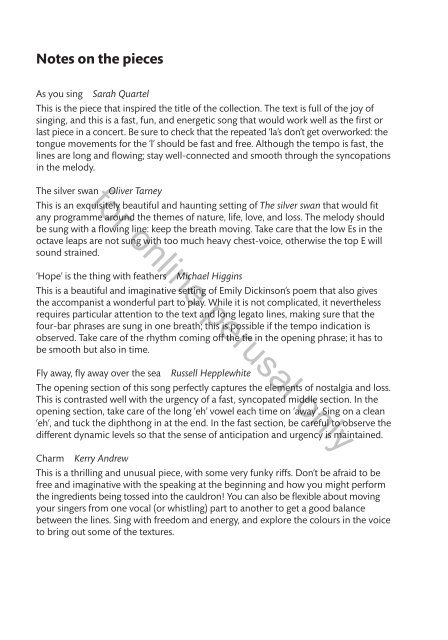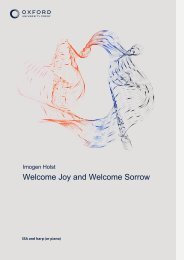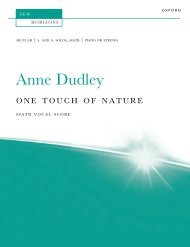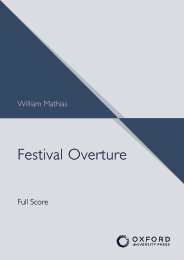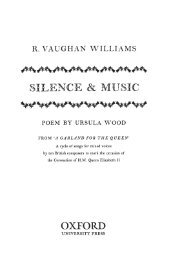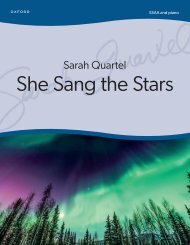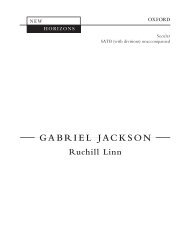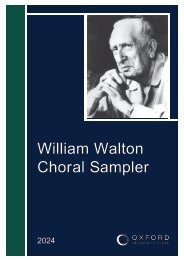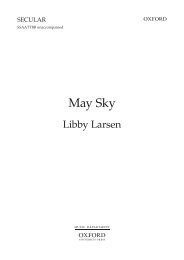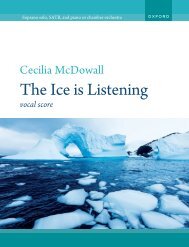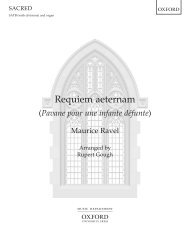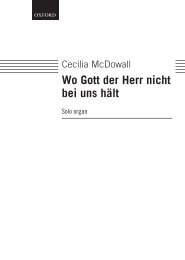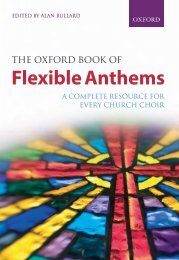As You Sing
A celebration of Oxford's popular Songbird series, this collection of nine original works for upper voices in two, three, and four parts meets the need for fresh concert repertoire for youth and women's choirs. Featuring well-known composers such as Kerry Andrew, Cecilia McDowall, and Sarah Quartel, the collection includes a variety of styles and moods and a selection of pieces that are all melodically appealing and immediately approachable, with a contemporary twist. Texts from across the years touch on a range of themes, from the empowering to the quirky, with a particular emphasis on the natural world. Performance notes from compilers Neil Ferris and Joanna Tomlinson provide invaluable tips for rehearsal and performance, making this a complete and practical collection for contemporary upper-voice choirs.
A celebration of Oxford's popular Songbird series, this collection of nine original works for upper voices in two, three, and four parts meets the need for fresh concert repertoire for youth and women's choirs. Featuring well-known composers such as Kerry Andrew, Cecilia McDowall, and Sarah Quartel, the collection includes a variety of styles and moods and a selection of pieces that are all melodically appealing and immediately approachable, with a contemporary twist. Texts from across the years touch on a range of themes, from the empowering to the quirky, with a particular emphasis on the natural world. Performance notes from compilers Neil Ferris and Joanna Tomlinson provide invaluable tips for rehearsal and performance, making this a complete and practical collection for contemporary upper-voice choirs.
Create successful ePaper yourself
Turn your PDF publications into a flip-book with our unique Google optimized e-Paper software.
Notes on the pieces<br />
<strong>As</strong> you sing<br />
Sarah Quartel<br />
This is the piece that inspired the title of the collection. The text is full of the joy of<br />
singing, and this is a fast, fun, and energetic song that would work well as the first or<br />
last piece in a concert. Be sure to check that the repeated ‘la’s don’t get overworked: the<br />
tongue movements for the ‘l’ should be fast and free. Although the tempo is fast, the<br />
lines are long and flowing; stay well-connected and smooth through the syncopations<br />
in the melody.<br />
The silver swan Oliver Tarney<br />
This is an exquisitely beautiful and haunting setting of The silver swan that would fit<br />
any programme around the themes of nature, life, love, and loss. The melody should<br />
be sung with a flowing line: keep the breath moving. Take care that the low Es in the<br />
octave leaps are not sung with too much heavy chest-voice, otherwise the top E will<br />
sound strained.<br />
for online perusal only<br />
‘Hope’ is the thing with feathers Michael Higgins<br />
This is a beautiful and imaginative setting of Emily Dickinson’s poem that also gives<br />
the accompanist a wonderful part to play. While it is not complicated, it nevertheless<br />
requires particular attention to the text and long legato lines, making sure that the<br />
four-bar phrases are sung in one breath; this is possible if the tempo indication is<br />
observed. Take care of the rhythm coming off the tie in the opening phrase; it has to<br />
be smooth but also in time.<br />
Fly away, fly away over the sea Russell Hepplewhite<br />
The opening section of this song perfectly captures the elements of nostalgia and loss.<br />
This is contrasted well with the urgency of a fast, syncopated middle section. In the<br />
opening section, take care of the long ‘eh’ vowel each time on ‘away’. <strong>Sing</strong> on a clean<br />
‘eh’, and tuck the diphthong in at the end. In the fast section, be careful to observe the<br />
different dynamic levels so that the sense of anticipation and urgency is maintained.<br />
Charm Kerry Andrew<br />
This is a thrilling and unusual piece, with some very funky riffs. Don’t be afraid to be<br />
free and imaginative with the speaking at the beginning and how you might perform<br />
the ingredients being tossed into the cauldron! <strong>You</strong> can also be flexible about moving<br />
your singers from one vocal (or whistling) part to another to get a good balance<br />
between the lines. <strong>Sing</strong> with freedom and energy, and explore the colours in the voice<br />
to bring out some of the textures.


